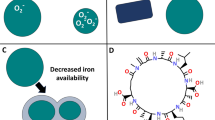Abstract
Iron oxidation by bacteria isolated from an estuary was inhibited completely by sodium chloride. At 3% (wt/vol) salt, no iron oxidation occurred. Bacteria could be partially adapted to 1.5% (wt/vol) NaCl, but even at this salinity iron oxidation was much reduced. Montmorillonite, a clay mineral, afforded some protection against salt toxicity. The results indicate that iron-oxidizing bacteria are confined to areas of low salinity to freshwater in the estuary and are apparently absent in the marine environment.
Similar content being viewed by others
Literature Cited
Bewers, J. M., Macaulay, I. D., Sundby, B. 1974. Trace metals in the waters of the Gulf of St. Lawrence. Canadian Journal of Earth Sciences11:939–950.
Bewers, J. M., Yeats, P. A. 1978. Trace metals in the waters of a partially mixed estuary. Estuarine and Coastal Marine Science7:147–162.
Boyle, E., Collier, P., Dengler, A. J., Edmond, J. M., Ng, A. C., Stallard, R. F. 1974. On the chemical mass balance of estuaries. Geochimica et Cosmochimicha Acta38:1719–1728
Briery, C. L. 1978. Bacteria leaching. Critical Reviews in Microbiology5:207–262.
Cameron, F. J., Edwards, C., Jones, M. V. 1981. Isolation and preliminary characterization of an iron-oxidizing bacterium from an ochre-polluted stream. Journal of General Microbiology124:213–217.
Cullimore, D. R., McCann, A. E. 1977. The identification, cultivation and control of iron bacteria in ground water, pp. 219–259. In: Skinner, F. A., Shewan, J. M. (eds.), Aquatic microbiology London: Academic Press.
Ghiorse, W. C., Hirsch, P. 1979. An ultrastructural study of iron and manganese deposition associated with extracellular polymers of Pedomicrobium-like budding bacteria. Archives of Microbiology123:213–226.
Harrison, A. P. 1978. Microbial succession and mineral leaching in an artificial coal spoil. Applied and Environmental Microbiology36:861–869.
Ingledew, W. J. 1982.Thiobacillus ferrooxidans, the bioenergetics of an acidophilic chemolithotroph. Biochemica et Biophysica Acta683:89–117.
Lundgren, D. G., Dean, W. 1979. Biogeochemistry of iron, pp. 211–251. In: Trudinger, P. A., Swaine, D. J. (eds.), Biogeochemical cycling of mineral-forming elements. Amsterdam: Elsevier.
Manning, H. 1975. New medium for isolating iron-oxidizing and heterotrophic acidophiles from acid mine drainage. Applied Microbiology30:1010–1016.
Ridgway, H. F., Olson, B. H. 1981. Scanning electromicroscopic evidence for bacterial colonization of a drinkingwater distribution system. Applied and Environmental Microbiology41:274–287.
Roper, M. M., Marshall, K. C. 1979. Effects of salinity on sedimentation and of particulates on survival of bacteria in estuarine habitats. Geomicrobiology Journal1:103–116.
Sandell, E. B. 1959. In: Colorimetric determination of traces of metals, 3rd edn. New York: Interscience.
Stotszky, G. 1980. Surface interaction between clay minerals and microbes, viruses and soluble organics, and the probable importance of these interactions to the ecology of microbes in soil, pp. 231–247. In: Berkeley, R. W. C., Lynch, J. M., Melling, J., Rutter, P. R., Vincent, B. (eds), Microbial adhesion to surfaces. Chichester, UK: Ellis Harwood.
Tuovinen, O. H., Nurmiaho, E. 1979. Microscopic examination of bacteria in Fe111-oxide deposited from ground water. Microbial Ecology5:57–66.
Vishniac, W. V. 1974. Genus 1. Thiobacillus Beijerinck 1904, pp. 456–461. In: Buchanan, R. E., Gibbons, N. E. (eds), Bergey's manual of determinative bacteriology, 8th edn. Baltimore: Williams and Wilkins.




